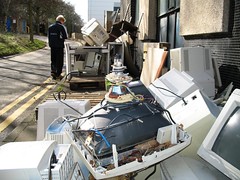Thursday, April 20, 2006
My day in York
Yesterday I went down to York to speak about my work at a postgraduate symposium. There were 12 organic postgrads speaking from various universities in the north and all of us had been through a nomination and selection proceedure. Eleanor and I were representing Durham the event was really eye-opening for me in several ways. Firstly, I'm sad to say that not one person from my group came down with me - I think I was the only person there by themselves. It didn't bother me, but it made me realise just how bad our group is as a group - we work well in the department, but really don't have any contact outside of that which is a shame as almost every other group does and they seem closer because of it. Secondly, apart from Eleanor, me and one of the speakers from York, everyone was working on total synthesis of natural products. These are large complicated chemicals that are made in nature (at the moment the hype is behind stuff made by marine organisms such as coral and sponges). The compound extracted from the natural source might show some potential therapeutic benefits so they are deemed "interesting". Now, for those of you who don't know it is very unlikely that the molecule "as it is" will be at all suitable for use in a drug - there's normally an active part (or pharmacophore) that instills the biological activity into the substance. In spite of this there are lots of research groups that embark on "total syntheses" of the original molecule from smaller commercially available chemicals. The challenge is to reproduce all the complexity nature has put into the molecule using the chemistry we know. It has to be said that a lot of hard work and very elegant chemistry goes into these syntheses - total syntheses often take years and many PhD students before they are complete. However, they really aren't particularly useful - pharmaceutical companies won't touch the routes because of the multiple steps, frequent low yields and far ranging chemicals needed. Frequently, products are formed in exceedingly low yields (one value quoted was 15mg of product - that's not even enough to prove what it is!). I'm now very happy that my PhD is on useful materials. Total synthesis is very good for gaining knowledge of a wide range of techniques, but at the end of the day, you're working towards a well defined goal. With my work I also design the goal as well as the route to it.
Sunday, April 16, 2006
My chemisty dinner party
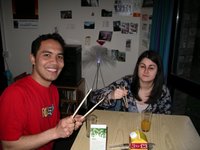 Last week* Blondie invited 2 of our friends from the chemistry departmet, Emma and Khairul around for dinner. Eager to show off our culinery skills, we devised a Japanese meal fresh from Matt's Wagamama book and my patented French chocolate cake. Since Khirul is muslim, we had to use halal meat - meat that must be facing east when slaughtered and killed by draining its life-blood. Halal or not it was certainly the best quality meat I've seen in a while -
Last week* Blondie invited 2 of our friends from the chemistry departmet, Emma and Khairul around for dinner. Eager to show off our culinery skills, we devised a Japanese meal fresh from Matt's Wagamama book and my patented French chocolate cake. Since Khirul is muslim, we had to use halal meat - meat that must be facing east when slaughtered and killed by draining its life-blood. Halal or not it was certainly the best quality meat I've seen in a while -  supermakets pump their meat full of water to enhace its appearence and my usual fallback, Iceland, seem to have resorted to the grade F supplies as the breasts fall apart as you try to cut them. Thankfully the cooking went off without a hitch (well it was all very easy) and the food was appreciated (until I let them know exacly how much fat and sugar was in the pudding). It's great to enjoy cooking again. In the 2nd year we had a brand new Ikea kitchen in the house and y cooking came to the fore: roasts, cakes, full meals. Then our 4th year house had a kitchen about 5' square.
supermakets pump their meat full of water to enhace its appearence and my usual fallback, Iceland, seem to have resorted to the grade F supplies as the breasts fall apart as you try to cut them. Thankfully the cooking went off without a hitch (well it was all very easy) and the food was appreciated (until I let them know exacly how much fat and sugar was in the pudding). It's great to enjoy cooking again. In the 2nd year we had a brand new Ikea kitchen in the house and y cooking came to the fore: roasts, cakes, full meals. Then our 4th year house had a kitchen about 5' square.  Cooking was largely an in-an-out experience as my 4th year houemates weren't exactly au-fait with the washing up so deciding what to cook usually boiled down to what was clean or whatever required the least amount of pre-washing up. The pantry on J2 was nowhere near big or stocked enough for 6 postgrads all wanting to cook at once - especially hen we had "extras" on the landing. Thankfully, our house kitchen (although small) is perfectly sized for the 3 of us and Easter has reminded Bondie and I how exciting cooking can be. Hopefully the days of rice and meat in a bought sauce (yawn) are over.
Cooking was largely an in-an-out experience as my 4th year houemates weren't exactly au-fait with the washing up so deciding what to cook usually boiled down to what was clean or whatever required the least amount of pre-washing up. The pantry on J2 was nowhere near big or stocked enough for 6 postgrads all wanting to cook at once - especially hen we had "extras" on the landing. Thankfully, our house kitchen (although small) is perfectly sized for the 3 of us and Easter has reminded Bondie and I how exciting cooking can be. Hopefully the days of rice and meat in a bought sauce (yawn) are over. *I actually wrote this over a month ago, but only got the pictures yesterday.
*I actually wrote this over a month ago, but only got the pictures yesterday.
My Ghibli reviews continue with Kiki's Delivery Service
 To those not in the know or quick to judge, Majo no Takkyuubin (Kiki's Delivery Service) is a nothing more than a girly tale of a witch going to a city to continue her training. For those who are willing to look a bit deeper however, one of the best coming-of-age stories emerges.
To those not in the know or quick to judge, Majo no Takkyuubin (Kiki's Delivery Service) is a nothing more than a girly tale of a witch going to a city to continue her training. For those who are willing to look a bit deeper however, one of the best coming-of-age stories emerges.I first saw Kiki in 2003 at a free screening to celebrate the UK DVD launch. I went with my now-housemate and we both loved it. As the story starts, we find Kiki listening to her radio in the countryside. When she hears that the skies will be clear she decides to leave for her training year a week early. Her parents are sad to see her leave but support her as best they can. Leaving with only her broomstick, her father's radio and talking black cat Jiji she soon finds a seaside city, Korico, but her initial joy soon lessons as she finds the city folk, less than interested in her dramatic arrival, very indifferent to her presence. A chance encounter with the kindly (and heavily pregnant) baker Osono affords her her first friend and a room to live in. Kiki's only "skill" is flying so she decides to set up an express delivery service.
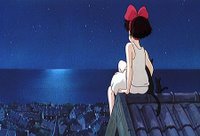 At first she struggles to find customers and even when she does, her first delivery is blighted by a small problem (loosing the package), but with the help of Jiji she successfully completes her assignment and makes another friend in the form of the easy-going artist Ursula. Gradually, Kiki makes more friends in the form Osono's husband Okino and, after an initial unease, local amateur pilot-in-waiting Tombo. However, she is still shy and uneasy around others so as she gets to know Tombo, his friends scare her off. Finally after a delivery to a rude customer causes her to miss a party and get her soaked through, Kiki wakes up the next day feeling terrible. Her illness turns to panic as she suddenly can't understand anything Jiji is saying and then discovers her powers of flight are failing. Osono urges Kiki to take some time off. It's at this point that Ursula pays Kiki a visit and convinces her to go and stay with her in the woods. It's here that Ursula tells Kiki about the time when she "lost" her painting ability. Kiki returns to Korico and resumes her deliveries on foot. A storm causes a series of events that puts one of Kiki's friends in danger. Kiki must now find the self-belief to reacquire her flying skills to help her friend.
At first she struggles to find customers and even when she does, her first delivery is blighted by a small problem (loosing the package), but with the help of Jiji she successfully completes her assignment and makes another friend in the form of the easy-going artist Ursula. Gradually, Kiki makes more friends in the form Osono's husband Okino and, after an initial unease, local amateur pilot-in-waiting Tombo. However, she is still shy and uneasy around others so as she gets to know Tombo, his friends scare her off. Finally after a delivery to a rude customer causes her to miss a party and get her soaked through, Kiki wakes up the next day feeling terrible. Her illness turns to panic as she suddenly can't understand anything Jiji is saying and then discovers her powers of flight are failing. Osono urges Kiki to take some time off. It's at this point that Ursula pays Kiki a visit and convinces her to go and stay with her in the woods. It's here that Ursula tells Kiki about the time when she "lost" her painting ability. Kiki returns to Korico and resumes her deliveries on foot. A storm causes a series of events that puts one of Kiki's friends in danger. Kiki must now find the self-belief to reacquire her flying skills to help her friend.
The beauty of this film is that it truly has relevance for every age group. For people who have left home, the biggest story is the emotional trauma of leaving home. Even though Kiki is excited to leave and can't wait to find her city, she soon finds that it isn't everything she wanted and that the shadowy truth of what it's like coping by yourself, especially in a new town, isn't easy. Finding yourself seemingly alone in a strange place is when you start to doubt yourself and in Kiki's case, it just takes a few things to go wrong before her self-doubts cause her to loose her "magic". The happy outcome is that she realises that she does have friends, who look out for her and help as best they can. By casting Kiki as a 13 year old girl, Miyazaki doesn't hammer home the modern day reality of leaving home. In the introduction to The art of Kiki's delivery service, Miyazaki writes, "... At one time the main characters of stories for young people gained financial independence, which was then equal to spiritual independence, after struggling through difficulties. In today's society, however, where anyone can earn money going from one temporary job to another, there is no connection between financial independence and spiritual independence. In this era, poverty is not so much material as spiritual.
In an era when leaving the security of one's home is no longer anything special, and living among strangers means nothing more than going to a convenience store for anything you need, it might be more difficult than ever to achieve a real sense of independence since you must go through the process of discovering your own talents and expressing yourself."
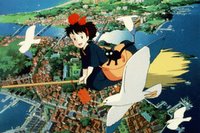 An important character is that of Jiji. He is both important in terms of the story and highlighting, once again, the difference of storytelling in the West and Japan. In the Japanese version, Jiji is a guide or guardian for Kiki. He only speaks occasionally and offers Kiki advice. In the Disney dub, Jiji - voiced by the late Phil Hartman - is a loudmouth wisecracking cat, with extra dialogue inserted to make him fit more with the wacky sidekick that US audiences are used to. The most important difference is that at the end of the film, in the US dub, Kiki can once again understand Jiji, where as in the Japanese dub, she can't and it is implied that Kiki has grown in character past the point where she needs Jiji to guide her. Similarly, the radio which acts as Kiki's reminder of home plays a different role in the different dubs. In the US dub, it's just a radio that plays constantly in the background, but in the Japanese dub, the radio is in Japanese as the film opens but when she arrives in Korico all the broadcasts are in a foreign language to her, hammering home her feeling of isolation as now even her keepsake from home has "turned" on her.
An important character is that of Jiji. He is both important in terms of the story and highlighting, once again, the difference of storytelling in the West and Japan. In the Japanese version, Jiji is a guide or guardian for Kiki. He only speaks occasionally and offers Kiki advice. In the Disney dub, Jiji - voiced by the late Phil Hartman - is a loudmouth wisecracking cat, with extra dialogue inserted to make him fit more with the wacky sidekick that US audiences are used to. The most important difference is that at the end of the film, in the US dub, Kiki can once again understand Jiji, where as in the Japanese dub, she can't and it is implied that Kiki has grown in character past the point where she needs Jiji to guide her. Similarly, the radio which acts as Kiki's reminder of home plays a different role in the different dubs. In the US dub, it's just a radio that plays constantly in the background, but in the Japanese dub, the radio is in Japanese as the film opens but when she arrives in Korico all the broadcasts are in a foreign language to her, hammering home her feeling of isolation as now even her keepsake from home has "turned" on her.Again, Miyazaki's love of flying features heavily (as it would for a film about a flying witch). The setting returns to a faux-European setting, blending in parts of the Med but also Stockholm and also uses an alternate timeline (set in the 50s as if WW2 never occurred). As with most Ghibli films, the film has an uplifting message and out of everyone I've shown this film to, without exception, all have loved it. It's a great way to get into the world of Ghibli and possibly the perfect film to watch if you ever feel alone and out of place.
Saturday, April 15, 2006
My younger days
I'm at home for Easter at the moment (edit - I was when I wrote this anyway). I use the word home with a bit of hesitance; so much has changed here since I went to university that only certain rooms are recognisable. Not much of the stuff I use a lot is here, so I try to help my parents clear up the house room by room. It's weird: they always used to be on at me to tidy my room, but now I see they're a lot worse than me - refusing even to throw junk mail away until they've both fully read it. This time the lounge was the room under scrutiny. Tidying consisted of sifting through the mountains of tapes and CDs, sorting out the dreaded photo draw and the shelving unit under the new LCD TV.  A lot of the photos have ended up in albums, but the ones that didn't (and all the negatives) just got shoved into a draw or to the back of a cabinet. Among the many packets of photos were images from my childhood and sorting through them brought back a load of memories. School trips out, my German exchange, trips to India and family pictures. These go back to a time when 6x4" prints were what posh people got.
A lot of the photos have ended up in albums, but the ones that didn't (and all the negatives) just got shoved into a draw or to the back of a cabinet. Among the many packets of photos were images from my childhood and sorting through them brought back a load of memories. School trips out, my German exchange, trips to India and family pictures. These go back to a time when 6x4" prints were what posh people got. 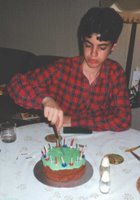 There were even some of my old photos that showed how bad I was at keeping my hands still. The amazing thing is how much my appearance changed over time. Even pictures from a time when I thought I looked much as do now revealed a visibly different version of me - mostly less embittered - and yet the memories of these events seems so vivid. Of course, the immediate difference is the hair. I'm amazed and horrified at the state of my hair in most of the pictures; it's so big! At the time my mother cut my hair so I blame her (even though I never combed it). Unfortunately even when I started going to a barber, the situation didn't improve as I made the mistake of choosing an unfortunate centre parting that for some reason stayed until my 2nd year at uni.
There were even some of my old photos that showed how bad I was at keeping my hands still. The amazing thing is how much my appearance changed over time. Even pictures from a time when I thought I looked much as do now revealed a visibly different version of me - mostly less embittered - and yet the memories of these events seems so vivid. Of course, the immediate difference is the hair. I'm amazed and horrified at the state of my hair in most of the pictures; it's so big! At the time my mother cut my hair so I blame her (even though I never combed it). Unfortunately even when I started going to a barber, the situation didn't improve as I made the mistake of choosing an unfortunate centre parting that for some reason stayed until my 2nd year at uni.
 The hardest this realising that the events in these photos happened so long ago, many from the 80s. Even those in the 90s are now getting on for 10 years ago. The most worrying one though was the picture of me, sporting a new gown (over a fleece - bad idea) in front of a massive Welcome to Trevs banner. 1999: seems like yesterday, it will be 7 years ago come October. Scary.
The hardest this realising that the events in these photos happened so long ago, many from the 80s. Even those in the 90s are now getting on for 10 years ago. The most worrying one though was the picture of me, sporting a new gown (over a fleece - bad idea) in front of a massive Welcome to Trevs banner. 1999: seems like yesterday, it will be 7 years ago come October. Scary.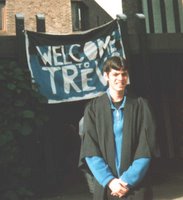
The other thing that triggers memories are the sounds that I am used to hearing. The sound of the washing machine reminds me of school holidays (for some reason especially the Christmas holiday). The sound of someone using the shower from my room reminds me of Sundays and there is just a feel about the house. I can't really explain it - there's something about the atmosphere that means if I close my eyes I just know I'm in the house I grew up in. Maybe it's the terrible carpets we have at Trevs, perhaps the extra comfort of a decent bed or maybe even the slightly cooler temperature. Who knows? One thing has grown to be the norm of my trips home - when I arrive I wish I was back in Durham and then when it comes to leaving I really don't want to leave. Even in Trevs so much has changed - carpets, networked rooms, refurbed bar, new beds, newly refurbed rooms. Will I even recognise it in 5 years? But that's probably another story.
 A lot of the photos have ended up in albums, but the ones that didn't (and all the negatives) just got shoved into a draw or to the back of a cabinet. Among the many packets of photos were images from my childhood and sorting through them brought back a load of memories. School trips out, my German exchange, trips to India and family pictures. These go back to a time when 6x4" prints were what posh people got.
A lot of the photos have ended up in albums, but the ones that didn't (and all the negatives) just got shoved into a draw or to the back of a cabinet. Among the many packets of photos were images from my childhood and sorting through them brought back a load of memories. School trips out, my German exchange, trips to India and family pictures. These go back to a time when 6x4" prints were what posh people got.  There were even some of my old photos that showed how bad I was at keeping my hands still. The amazing thing is how much my appearance changed over time. Even pictures from a time when I thought I looked much as do now revealed a visibly different version of me - mostly less embittered - and yet the memories of these events seems so vivid. Of course, the immediate difference is the hair. I'm amazed and horrified at the state of my hair in most of the pictures; it's so big! At the time my mother cut my hair so I blame her (even though I never combed it). Unfortunately even when I started going to a barber, the situation didn't improve as I made the mistake of choosing an unfortunate centre parting that for some reason stayed until my 2nd year at uni.
There were even some of my old photos that showed how bad I was at keeping my hands still. The amazing thing is how much my appearance changed over time. Even pictures from a time when I thought I looked much as do now revealed a visibly different version of me - mostly less embittered - and yet the memories of these events seems so vivid. Of course, the immediate difference is the hair. I'm amazed and horrified at the state of my hair in most of the pictures; it's so big! At the time my mother cut my hair so I blame her (even though I never combed it). Unfortunately even when I started going to a barber, the situation didn't improve as I made the mistake of choosing an unfortunate centre parting that for some reason stayed until my 2nd year at uni. The hardest this realising that the events in these photos happened so long ago, many from the 80s. Even those in the 90s are now getting on for 10 years ago. The most worrying one though was the picture of me, sporting a new gown (over a fleece - bad idea) in front of a massive Welcome to Trevs banner. 1999: seems like yesterday, it will be 7 years ago come October. Scary.
The hardest this realising that the events in these photos happened so long ago, many from the 80s. Even those in the 90s are now getting on for 10 years ago. The most worrying one though was the picture of me, sporting a new gown (over a fleece - bad idea) in front of a massive Welcome to Trevs banner. 1999: seems like yesterday, it will be 7 years ago come October. Scary.
The other thing that triggers memories are the sounds that I am used to hearing. The sound of the washing machine reminds me of school holidays (for some reason especially the Christmas holiday). The sound of someone using the shower from my room reminds me of Sundays and there is just a feel about the house. I can't really explain it - there's something about the atmosphere that means if I close my eyes I just know I'm in the house I grew up in. Maybe it's the terrible carpets we have at Trevs, perhaps the extra comfort of a decent bed or maybe even the slightly cooler temperature. Who knows? One thing has grown to be the norm of my trips home - when I arrive I wish I was back in Durham and then when it comes to leaving I really don't want to leave. Even in Trevs so much has changed - carpets, networked rooms, refurbed bar, new beds, newly refurbed rooms. Will I even recognise it in 5 years? But that's probably another story.
Monday, April 10, 2006
My crimson pig
 It's been a pretty quiet weekend. One of my housemates has gone home for Easter and the other one has been out a lot. Apart from a couple of trips into town to pick up The Independent for their free Instant German guide and CD (I've now got 2 languages to learn/get back into) it's been pretty dull. The freakish April weather (sunny to rain to snow (and I mean proper snow) to sleet to bright sunshine) has been toying with me so I've had the chance to get some decent updates to this site.
It's been a pretty quiet weekend. One of my housemates has gone home for Easter and the other one has been out a lot. Apart from a couple of trips into town to pick up The Independent for their free Instant German guide and CD (I've now got 2 languages to learn/get back into) it's been pretty dull. The freakish April weather (sunny to rain to snow (and I mean proper snow) to sleet to bright sunshine) has been toying with me so I've had the chance to get some decent updates to this site.The third Ghibli review of the weekend is the curious film that is Kurenai no buta (Porco Rosso). This film was originally conceived as a 30-40 minute "short" for, as Miyazaki put it, "a movie which tired businessmen on international flights can enjoy even with their minds dulled due to lack of oxygen" on JAL flights. As work on the film matured it became clear that it should be upgraded into a full-length feature. JAL still got to premiere the film on their flights, but Porco Rosso also became a huge hit in the cinemas of Japan in 1992. The story centres on Marco "Porco" Paggot, a humanoid cursed to live with the head of a pig. He lives by himself on a small island making his living collecting the bounty on sea pirates that plague the Adriatic. The introduction to the films sees Porco foil a raid by the Mamma Auito ("Mummy, Help!" gang). The pirates, frustrated by Porco's continuing interference hire ace US pilot and aspiring actor Donald Curtis to take Porco down. We are then introduced to Gina, a singer at a local bar, who is loved by all the men, but who holds a place in her heart for Marco. She seems to be the one person who remembers him as a human before his curse. Gina has been widowed by pilots several times. Curtis ambushes Porco who is on his way to have his plane repaired in Italy and shoots him down. Arriving secretly in Italy with his battered plane, Porco encounters Fio, the feisty daughter of his usual mechanic, who sets about designing the modifications to Porco's new plane.
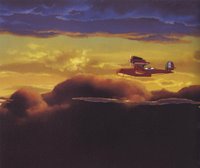 Set in the late 1920s, fascism is on the rise and the authorities are after Porco. We are not told why, but it is implied that he deserted from the Italian air force after he grew disillusioned. As he returns to duel with Curtis on equal terms, he is persuaded to take Fio with him. Fio asks the questions that the audience want to know. As usual, Miyazaki doesn't provide us with the answers on a spoon, we have to find them. Porco tells Fio a story of a WW1 battle where his best friend (and Gina's 1st husband) was killed. He mentions an ethereal cloud made of planes piloted by those who have been been lost in battle that is taken from a Rohl Dahl story - Miyazaki loves Dahl's more mature works. Porco and Fio are ambushed by the Mama Auito gang and the duel with Curtis is set up. The stakes are high and Gina learns that the fascists are on their way and sets out to warn Porco.
Set in the late 1920s, fascism is on the rise and the authorities are after Porco. We are not told why, but it is implied that he deserted from the Italian air force after he grew disillusioned. As he returns to duel with Curtis on equal terms, he is persuaded to take Fio with him. Fio asks the questions that the audience want to know. As usual, Miyazaki doesn't provide us with the answers on a spoon, we have to find them. Porco tells Fio a story of a WW1 battle where his best friend (and Gina's 1st husband) was killed. He mentions an ethereal cloud made of planes piloted by those who have been been lost in battle that is taken from a Rohl Dahl story - Miyazaki loves Dahl's more mature works. Porco and Fio are ambushed by the Mama Auito gang and the duel with Curtis is set up. The stakes are high and Gina learns that the fascists are on their way and sets out to warn Porco.The rest of this review contains some spoilers to the ending of the film so be warned.
It is hinted that at the same time Marco left the Italian AF, he became so disillusioned by humanity that his curse was self-imposed. As his duel with Curtis comes to blows, Gina arrives and helps Porco to realise that there was still some hope for humanity as he experienced Fio's innocence and Gina's love. At the end we are left with a pull-out shot from above where Curtis suddenly demands to look at Porco's face - has he lifted his own curse and become human again? Another, vague point left floating is Gina and Porco's relationship. Gina tells Curtis that she can't accept his proposal as she has a bet with herself that Porco will one day confess his love for her. Fio's narration closes that film, leaving the question unanswered, but looking closely at the bar, shows Porco's red plane moored up behind Gina's house suggesting a happy ending. Miyazaki has also dropped hints that Porco and Gina did get married.
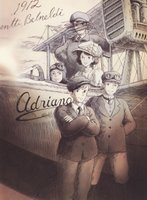 The usual theme of flying is here; more so than any other film. This was a real labour of love for Miyazaki and the aerial sequences are breathtaking. Every move of the joystick, press on the rudder pedals and throttle adjustment is shown and the pure freedom of open-cockpit seaplane flight is felt by all who watch it. The period is a very romantic one - Gina's sultry song at the bar wows all who see it and the feelings that her and Marco share for each other are very strong. It is only Marco's lack of faith in humanity that keeps them apart. Gina has been widowed 3 times before by pilots so why should he risk making it 4? Surprisingly, the film came out in several European countries and Miyazaki has gone on record as saying that the French dub (starring Jean Reno as Porco) he his preferred soundtrack given the very European setting of the film. Again, there are no evil characters - the pirates are only interested in money and come across as being almost lovable rogues (especially when they compete to be in the photograph with Fio). Curtis is simply looking to further his name to help his film star aspirations and shooting down Porco Rosso will help him no end. Interestingly, it is out hero that displays almost antihero traits. He isn't interested in helping people, just the bounty that he can collect on the pirates he foils. His world-weariness, gruff demeanor and refusal to acknowledge Gina's love make him almost unlikeable at first. As he recalls the battle which led him to see the procession of ethereal planes, Fio starts to see his face change to that of a human. In many ways, we can conclude that Fio is the true hero of Porco Rosso. She will do anything for Porco and even offers herself as his wager for the duel. Her determination to succeed and find the cause of Marco's curse mean that she fits into the Miyazaki temple of young female heroines in his films.
The usual theme of flying is here; more so than any other film. This was a real labour of love for Miyazaki and the aerial sequences are breathtaking. Every move of the joystick, press on the rudder pedals and throttle adjustment is shown and the pure freedom of open-cockpit seaplane flight is felt by all who watch it. The period is a very romantic one - Gina's sultry song at the bar wows all who see it and the feelings that her and Marco share for each other are very strong. It is only Marco's lack of faith in humanity that keeps them apart. Gina has been widowed 3 times before by pilots so why should he risk making it 4? Surprisingly, the film came out in several European countries and Miyazaki has gone on record as saying that the French dub (starring Jean Reno as Porco) he his preferred soundtrack given the very European setting of the film. Again, there are no evil characters - the pirates are only interested in money and come across as being almost lovable rogues (especially when they compete to be in the photograph with Fio). Curtis is simply looking to further his name to help his film star aspirations and shooting down Porco Rosso will help him no end. Interestingly, it is out hero that displays almost antihero traits. He isn't interested in helping people, just the bounty that he can collect on the pirates he foils. His world-weariness, gruff demeanor and refusal to acknowledge Gina's love make him almost unlikeable at first. As he recalls the battle which led him to see the procession of ethereal planes, Fio starts to see his face change to that of a human. In many ways, we can conclude that Fio is the true hero of Porco Rosso. She will do anything for Porco and even offers herself as his wager for the duel. Her determination to succeed and find the cause of Marco's curse mean that she fits into the Miyazaki temple of young female heroines in his films.Being an avid flight-enthusiast, Porco Rosso is my favourite Miyazaki. One of the joy's of Ghibli films is that so many genres are covered; fantasy (Spirited away, Howl's Moving Castle, The cat returns), drama (Whisper of the Heart, Grave of the fireflies), adventure (Porco Rosso, Laputa) and many more. This ensures that there is no one defining "best" film. Any of the films can be someone's favorite. Porco Rosso is one of the more adult films Ghibli have produced, perhaps showing some trace of original plan to show it to businessmen. It's got nothing inappropriate for children, but the themes explored are definaitely more mature and not many children are likely to identify with Porco's world-weariness. But beyond the simple feeling of freedom in the flight sequences is the joy of Marco rediscovering his faith in humanity, the mysteries that can be cleared up by watching closely and wonderful period music. I'm sure many will disagree, but for me this is the perfect Ghibli film.
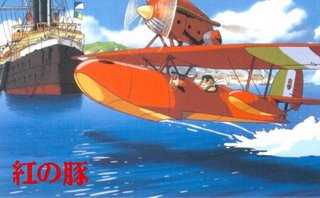
Sunday, April 09, 2006
My take on Laputa: castle in the sky
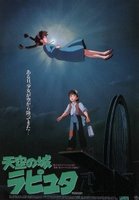 One December Saturday morning in 1989 (I think) I came downstairs and started watching tv. Nothing too ordinary about that, but what was on ITV for once was different. It was a cartoon, but had a certain "something" about it that made it appear different to all the western/Disney cartoons I'd seen. It started in a small village on the edge of a cliff and featured 2 children who were being hunted by both the government and a group of sinister pirates. Eventually, the girl was captured (by the government) and shown a giant, broken robot that had fallen from the sky and provided the first physical evidence of a floating in the sky. The adventure then took to the sky as it turned out that the pirates weren't as bad as they first appeared. The memory gets a little hazy (I was only 9) especially as I wasn't used to 2hr cartoons.
One December Saturday morning in 1989 (I think) I came downstairs and started watching tv. Nothing too ordinary about that, but what was on ITV for once was different. It was a cartoon, but had a certain "something" about it that made it appear different to all the western/Disney cartoons I'd seen. It started in a small village on the edge of a cliff and featured 2 children who were being hunted by both the government and a group of sinister pirates. Eventually, the girl was captured (by the government) and shown a giant, broken robot that had fallen from the sky and provided the first physical evidence of a floating in the sky. The adventure then took to the sky as it turned out that the pirates weren't as bad as they first appeared. The memory gets a little hazy (I was only 9) especially as I wasn't used to 2hr cartoons.Fast forward to 2002 and a thread on the DVD Forums suddenly reminded me of that film. I could now be pretty much assured that is was a Japanese film and this was what gave it its distinctive look (anime uses fewer "in betweens" that western films). Asking around and describing the few details I remembered (the robot, the pirates that turn out to be ok and floating island) came up with the film Tenkû no shiro Rapyuta (Laputa: castle in the sky). Yet another film from Ghibli co-founder Miyazaki, this is actually the first film from the studio founded after the success of Nausicaa.
The story starts in an airship, where a girl called Sheeta is being guarded by suspicious-looking men. A raid by air-pirates seems to be targeted at Sheeta, but before the pirates can capture her she falls from the airship. Suddenly, the stone that hangs around her neckeruptss into light and causes her to float gently down to earth. Here she is found by Pazu, a young local mine worker. He agrees to help her and they set off being chased by two groups, with both Pazu and Sheeta unaware of Sheeta's importance. This is one of several "retro-future" films from Ghibli where a early 20th century technology (giant woodern railways across precipices, a lack of widespread electricity) is mixed with bizarre technology such as giant airships and armoured trains. The look of Pazu's village was inspired by the Welsh mining towns that Miyazaki saw during a location scouting trip. The depressed nature of the workers coming from the miners' strikes that had just finished at the time of his visit. The chase eventually leads us to some clues about the importance of Sheeta and her stone before the second half of the film takes us to the skies in search of the mystical floating island of Laputa. All the different characters want to find Laputa for their own reasons - Pazu to prove his father, who was mocked with his tales of the island, was telling the truth, Sheeta grows curious of her heritage and believes it may lie in the sky, the pirate clan lead by Dola believe Laputa to be full of riches, the army are worried that the technology that keeps Laputa afloat may be a danger to them and sinister agent Muska seems to have his own agenda over that of the government.
 This is very much an adventure story for children of all ages. It's yet another example of how our culture differs from that in Japan. In a scene where the children are caught by the army, we see an agent pistol-whip Pazu to the ground - something that would never have seen the light of day in a Disney film. Those expecting an action packed resolution are likely to be disappointed (don't get me wrong, there is a lot of action at the end of the film) as once again, like so many Japanese stories, the climax is more spiritual and human that all that has gone before. Miyazaki's love of flying again comes to the fore with some exilarating aerial sequences and once again, several of the "bad guys" may not seem as evil as they are when the film starts. The one exception to this is Muska. I think I can safely say that he is the most evil character in a Miyazaki film to date and seems to lack any redeeming qualities. The theme of nature and man's quest for domination comes around too. Muska shows Sheeta a giant robot that fell from the sky. Later Sheeta recants a "spell" taught to her by her grandmother that reactivates the robot. Its primal instinct is to protect Sheeta and a massive fire fight between the robot and the army ensues as the robot battles to get to Sheeta and keep her safe, with the massive firepower of the Laputian technology decimating the army's fortress. Later we see another robot, alone on the island itself. It tends a grave with flowers and even moves the glider the children arrive in away from a birds nest. Even thought the robot cannot communicate beyond beeps, we can see that it bears no agression to the newcommers at all.
This is very much an adventure story for children of all ages. It's yet another example of how our culture differs from that in Japan. In a scene where the children are caught by the army, we see an agent pistol-whip Pazu to the ground - something that would never have seen the light of day in a Disney film. Those expecting an action packed resolution are likely to be disappointed (don't get me wrong, there is a lot of action at the end of the film) as once again, like so many Japanese stories, the climax is more spiritual and human that all that has gone before. Miyazaki's love of flying again comes to the fore with some exilarating aerial sequences and once again, several of the "bad guys" may not seem as evil as they are when the film starts. The one exception to this is Muska. I think I can safely say that he is the most evil character in a Miyazaki film to date and seems to lack any redeeming qualities. The theme of nature and man's quest for domination comes around too. Muska shows Sheeta a giant robot that fell from the sky. Later Sheeta recants a "spell" taught to her by her grandmother that reactivates the robot. Its primal instinct is to protect Sheeta and a massive fire fight between the robot and the army ensues as the robot battles to get to Sheeta and keep her safe, with the massive firepower of the Laputian technology decimating the army's fortress. Later we see another robot, alone on the island itself. It tends a grave with flowers and even moves the glider the children arrive in away from a birds nest. Even thought the robot cannot communicate beyond beeps, we can see that it bears no agression to the newcommers at all.  A lifesize Laputian robot stands atop the roof of the Ghibli museum in Mitaka. The delightful relationship that devlelops between the two children is at the centre of the human story. They have a totally innocent love for each other that pirate leader Dola tries to get her many sons to understand.
A lifesize Laputian robot stands atop the roof of the Ghibli museum in Mitaka. The delightful relationship that devlelops between the two children is at the centre of the human story. They have a totally innocent love for each other that pirate leader Dola tries to get her many sons to understand.In 1999, the original Streamline dub that was shown on ITV all those years ago was replaced by a brand new Disney supervised effort. I haven't yet heard it but it has drawn equal amount of praise and disgust. If James Van der Beek was hard to take as a teenager in Dawson's Creek, then I imagine he's equally hard to take as the 11 or 12 year old Pazu. Mark Hamill (who has had a successful voice over career since fading from the acting limelight of the Star Wars films) voices Muska and Cloris Leachman voices Dola (both these roles have drawn praise). Even more contentious among fans is Disney's commissioning Joe Hisaishi to extend the score.
 Where the Japanese track features long periods of silence, Disney felt western audiences would feel ill at ease with this. The reports on the extension are pretty good and Miyazaki was quite happy to let the change take place. If you buy the R1/2/4 version you have the chance to listen to both the new English dub and the original Japanese recording. The score (like Nausicaa) is still a little synth-heavy (it was 1986) but still has some excellent themes. Whilst Disney was unable to edit any of the film due to the terms of their contract with Ghibli, they did change the title of the film as they were worried that the name Laputa ("the whore" in Spanish) wouldn't go down too well in the US. All other regions are unaffected by this change. This is another example of how to create a film that will captivate children and adults alike. It seems that no matter what subject Miyazaki tackles he injects such a fantastic vision that isn't impossible not to be transfixed. This is essentially an excellent grounding in his themes: we have flight, how man misuses power available to him and its impact on nature, leading characters who are children and a great love between 2 of of the characters and people who's motives seem to change over the course of the film and an "alternate-reality" European setting - all of these feature in his other works.
Where the Japanese track features long periods of silence, Disney felt western audiences would feel ill at ease with this. The reports on the extension are pretty good and Miyazaki was quite happy to let the change take place. If you buy the R1/2/4 version you have the chance to listen to both the new English dub and the original Japanese recording. The score (like Nausicaa) is still a little synth-heavy (it was 1986) but still has some excellent themes. Whilst Disney was unable to edit any of the film due to the terms of their contract with Ghibli, they did change the title of the film as they were worried that the name Laputa ("the whore" in Spanish) wouldn't go down too well in the US. All other regions are unaffected by this change. This is another example of how to create a film that will captivate children and adults alike. It seems that no matter what subject Miyazaki tackles he injects such a fantastic vision that isn't impossible not to be transfixed. This is essentially an excellent grounding in his themes: we have flight, how man misuses power available to him and its impact on nature, leading characters who are children and a great love between 2 of of the characters and people who's motives seem to change over the course of the film and an "alternate-reality" European setting - all of these feature in his other works.
Saturday, April 08, 2006
My neighbour Totoro
 For some reason, I've decided not to do my reviews of the Ghibli films in order of release. Instead I'll continue with one of the most loved - Tonari no Totoro (My neighbour Totoro). There are times when a film has had so many recomendations that it can't possibly live up to the hype. Sadly for me, several Ghibli films fall into this category. I first bought Totoro as an R3HK import in summer 2004. I'd read so many things about it ("best Ghibli film ever", "the bus stop sequence is perfect" etc) that I was expecting the best anime of all time. Of course, it wasn't annd I was disappointed. The recent UK release rekindled my interest if only because it wasn't an NTSC-PAL conversion (if you don't know what that means - don't worry) so I thought I'd rebuy it and give it another viewing. I'm very glad I did as it's an amazing film. It's the sort of film that will make anyone nostalgic for their childhoods when we had no stresses about work, exams, jobs and relationships. Seen through the eyes of Satsuki and her younger sister Mei (both names comming from the month of May). It is set in rural Japan, possibly in the 1950s. Together with their father, an academic at Tokyo university, the girls move to the countryside to be nearer the hospital where their mother is recuperating. It's never said what actually wrong with her, but it's been suggested that she is recovering from TB (a desease Miyazaki's mother suffered from). The wonderful thing about this film, as with much of Miyazaki's magically heart-warming stories, is that there is no plot. This is simply a story that is seen from a child's view of the world. There are no evil baddies, no hint of peril of fears that must be overcome - simply a story. Much of the first half of Totoro sets up the girls' curiosity at their new surroundings. From the "dust bunnies" which seem to flee from sight whenever light is allowed into darkened areas, to the residents of the small village that the girls now call home. Eventually we meet the fantastic creatures that are the Totoros. Mei, exploring by herself whilst Satsuki is at school, catches sight of a small white creature which runs underneath the house. As Mei waits patiently by the hole she assumes is the only way back out, we see the creature, now joined by a bigger blue totoro creep past her carrying a sack full of acorns.
For some reason, I've decided not to do my reviews of the Ghibli films in order of release. Instead I'll continue with one of the most loved - Tonari no Totoro (My neighbour Totoro). There are times when a film has had so many recomendations that it can't possibly live up to the hype. Sadly for me, several Ghibli films fall into this category. I first bought Totoro as an R3HK import in summer 2004. I'd read so many things about it ("best Ghibli film ever", "the bus stop sequence is perfect" etc) that I was expecting the best anime of all time. Of course, it wasn't annd I was disappointed. The recent UK release rekindled my interest if only because it wasn't an NTSC-PAL conversion (if you don't know what that means - don't worry) so I thought I'd rebuy it and give it another viewing. I'm very glad I did as it's an amazing film. It's the sort of film that will make anyone nostalgic for their childhoods when we had no stresses about work, exams, jobs and relationships. Seen through the eyes of Satsuki and her younger sister Mei (both names comming from the month of May). It is set in rural Japan, possibly in the 1950s. Together with their father, an academic at Tokyo university, the girls move to the countryside to be nearer the hospital where their mother is recuperating. It's never said what actually wrong with her, but it's been suggested that she is recovering from TB (a desease Miyazaki's mother suffered from). The wonderful thing about this film, as with much of Miyazaki's magically heart-warming stories, is that there is no plot. This is simply a story that is seen from a child's view of the world. There are no evil baddies, no hint of peril of fears that must be overcome - simply a story. Much of the first half of Totoro sets up the girls' curiosity at their new surroundings. From the "dust bunnies" which seem to flee from sight whenever light is allowed into darkened areas, to the residents of the small village that the girls now call home. Eventually we meet the fantastic creatures that are the Totoros. Mei, exploring by herself whilst Satsuki is at school, catches sight of a small white creature which runs underneath the house. As Mei waits patiently by the hole she assumes is the only way back out, we see the creature, now joined by a bigger blue totoro creep past her carrying a sack full of acorns. 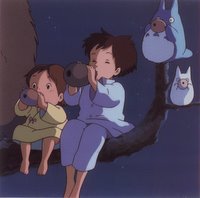 Eventually Mei sees them and gives chase with the excitement of a child that's found an amazing new toy. She winds up in the Totoros' layer under a tree. Lying asleep is a giant Totoro. Instead of being affraid, Mei is delighted by the giant furry creature which doesn't seem to mind her at all. When she tells her sister and father about her encounter, they don't disbelieve her as would happen in most western stories and Satsuki even writes to her mother telling her about Mei's encounter. Now we come to the famous bus stop scene. Whilst waiting for their fathers' bus to return from Tokyo, the girls are joined by the giant Totoro, who is getting wet with only a leaf for protectin from the rain. When Satsuki offers him an umbrella, Totoro studies it curiously and is delighted with the sound of rain on the canvas. When his special bus appears he gives the girls a pouch of seeds as a thank you. After planting the seeds, the girls have a night time encounter with the Totoros that again conjours up images of Raymond Briggs' The Snowman - the next day, they are gone, but some evidence of their adventure remains "It was a dream," shouts Satsuki, "but it wasn't a dream!"
Eventually Mei sees them and gives chase with the excitement of a child that's found an amazing new toy. She winds up in the Totoros' layer under a tree. Lying asleep is a giant Totoro. Instead of being affraid, Mei is delighted by the giant furry creature which doesn't seem to mind her at all. When she tells her sister and father about her encounter, they don't disbelieve her as would happen in most western stories and Satsuki even writes to her mother telling her about Mei's encounter. Now we come to the famous bus stop scene. Whilst waiting for their fathers' bus to return from Tokyo, the girls are joined by the giant Totoro, who is getting wet with only a leaf for protectin from the rain. When Satsuki offers him an umbrella, Totoro studies it curiously and is delighted with the sound of rain on the canvas. When his special bus appears he gives the girls a pouch of seeds as a thank you. After planting the seeds, the girls have a night time encounter with the Totoros that again conjours up images of Raymond Briggs' The Snowman - the next day, they are gone, but some evidence of their adventure remains "It was a dream," shouts Satsuki, "but it wasn't a dream!"As with the later Kiki's delivery service, the last act features a bit of suspense. While Kiki must overcome her self-doubt, in Totoro it is a outburst from Satsuki, upset at a cancellation of a visit from their mother, that upsets Mei and triggers the final meeting with the Totoros.
The wonder of the film is how Miyazaki captured the spirit of the 2 girls.
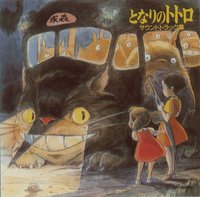 Even though grown-ups can't see the Totoros or their magical friends, at no time does the film go into the western stereotype of the adults not believing the children, but like The Snowman we are left with a wonderful daydream of a film in which the fantastical story we're seeing is magical enought that we want it to be true. Miyazaki has said that after the end of the film, the girls never saw the Totoros again (although a short film produced for the Ghibli Museum, Mei and the kittenbus suggests this might not be true) much like James loses his snowman. If you enjoyed Kiki's Delivery Service, it's almost certain you'll love this film too and vice versa. The new English dub, starring the Fanning sisters isn't really needed (and the American pronunciation of Totoro is very annoying), there is such little dialogue that the Japanese track is the way to go (especially with the new literal subtitles). I'm so glad I gave this film another chance. It makes you yearn to be a child again and brings back memories of lazy summer days when things were a lot simpler. As for Totoro himself, he went on to become the official Ghibli mascot, appearing in the Ghibli banner before all their films. It's very strange to think that this film was nearly never made, as funding was withheld until plans were drawn up to premiere this film alongside Isao Takahata's Grave of the fireflies which must have been one of the most bipolar double features of all time.
Even though grown-ups can't see the Totoros or their magical friends, at no time does the film go into the western stereotype of the adults not believing the children, but like The Snowman we are left with a wonderful daydream of a film in which the fantastical story we're seeing is magical enought that we want it to be true. Miyazaki has said that after the end of the film, the girls never saw the Totoros again (although a short film produced for the Ghibli Museum, Mei and the kittenbus suggests this might not be true) much like James loses his snowman. If you enjoyed Kiki's Delivery Service, it's almost certain you'll love this film too and vice versa. The new English dub, starring the Fanning sisters isn't really needed (and the American pronunciation of Totoro is very annoying), there is such little dialogue that the Japanese track is the way to go (especially with the new literal subtitles). I'm so glad I gave this film another chance. It makes you yearn to be a child again and brings back memories of lazy summer days when things were a lot simpler. As for Totoro himself, he went on to become the official Ghibli mascot, appearing in the Ghibli banner before all their films. It's very strange to think that this film was nearly never made, as funding was withheld until plans were drawn up to premiere this film alongside Isao Takahata's Grave of the fireflies which must have been one of the most bipolar double features of all time.Most people will pull out the Miyazaki theme of flying from his movies, but a much deeper theme, that permeates all the Ghibli films, not just Miyazaki's, is love. From Nausicaa's love for nature, Sophie's love for Howl and Gina's love for Marco (I'll mention the others is later reviews), here we have a close knit family - the 2 sisters rarely argue and Satsuki always looks after Mei. Their father, though hard-working, always makes time for his girls. It's the kind of idealistic family life that Miyazaki wants Japan (and the rest of us) to return to.
I'll try and post up some more review of Ghibli films over the weekend.
My new camera
Well - I eventually did it. After my traditional umming and arring over various models, pouring over every review I could find and then finally deciding to wait until all the new models had come out, I have (as usual) given in and bought one anyway. But, in my defence I've pulled something of a miracle. I was fully prepared to spend over £200 on the right model and had eventually narrowed it down to the Canon A610, the A620 or the new A700. Of course, I then discovered the Canon Outlet on eBay - where ex-demo and refurbished models are sold off cheaply. Essentially, my impatientness merged with the thrill of eBay and before I knew it I'd won a an A620 for only £160 (Argos price: £318). Now it's here I'm even more impressed. It may not have what a lot of people look for (large LCD and pocketability) but it's got a fantastic 2" rotatable LCD (perfect for self portraits and candid shots), full manual controls, a great selection of colour manipulation features and uses AAs so I can use my high powered NiMH batteries. I've already taken it out for a spin. Already I'm impressed with the vibrancy of colour over my old Minolta and the daffodil gives an example of one of the fancy "selective desaturation" effects. I still take out the minolta on nights out just because it's so compact, but the A620 still fits into a coat pocket easily. Better yet it will take conversion adaptors so I can extend the zoom (alread at 4x) and start using polarizers. Because I saved so much, I might still upgrade the Minolta to one of the new P&S models (Casio z600/z750, Ricoh R3/R4 or similar) if I find one cheap enough.
Subscribe to:
Comments (Atom)
